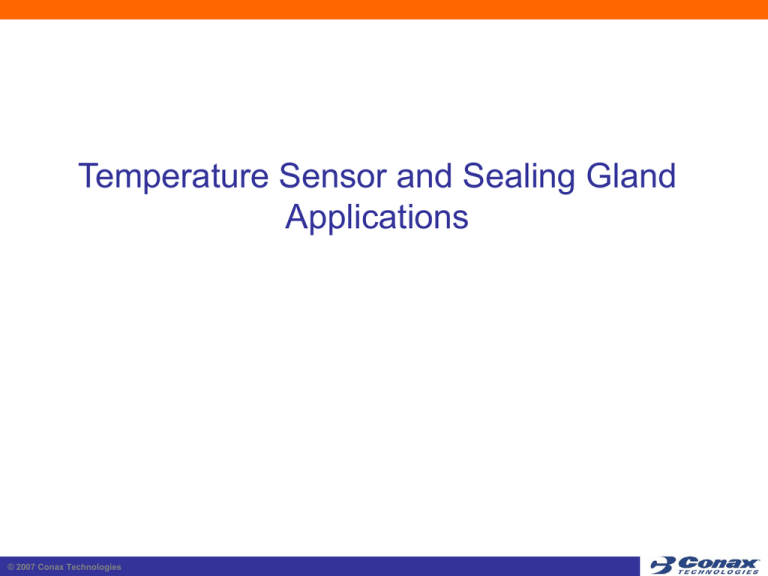Vertical Market Applications
advertisement

Temperature Sensor and Sealing Gland Applications © 2007 Conax Technologies Autoclaves/Furnaces • • • • • • Autoclaves Furnace – Kilns & Ovens (Non-Vacuum) Furnaces - Vacuum Heaters/Heat Treating/Metal Processing Sterilizers Hyperbaric Chambers © 2007 Conax Technologies Cement Kiln Manufacturer • Application Parameters: – Temperature: 330° C – High vibration – Material in kiln: Nickel laterite ore – Very abrasive material due to particle size and moisture weight • Customer Requirement: A thermocouple assembly rugged enough to measure ore temperature in a very abrasive, high vibration kiln environment. © 2007 Conax Technologies Cement Kiln Manufacturer • Conax Design Solution: – Type K thermocouple made of 8 AWG wire and beaded with alumina insulators – A 0.50″ 446SS Schedule 40 pipewell houses the 8 AWG Type K thermocouple assembly – A 3.00″ OD x 1.50″ ID heat resistant alloy Grade HT outer pipewell with a 5.24″ OD 310SS flange houses the 0.50″ Schedule 40 pipewell assembly – Outer Grade HT pipewell is coated with a 0.05″-0.06″ thick Nickel/Chrome/Boron coating for the first 3″ to provide abrasion resistance. © 2007 Conax Technologies Cement Kiln Manufacturer Kiln On-board Thermocouple © 2007 Conax Technologies Cement Kiln Manufacturer Kiln On-Board Thermocouple © 2007 Conax Technologies Steel Manufacturer • Customer Requirement: A thermocouple assembly capable of monitoring exhaust gas temperature in the stack of a blast furnace • Application Parameters: – Temperature: 1500°C – Pressure: 4 Bar – High velocity gas flow – Environment: coke, ore, hydrogen gas, debris – Insertion length in process: 60″ – Flow Rate: 90,000 cu ft/min – Exhaust Stack Pipe Diameter: 48″ © 2007 Conax Technologies Steel Manufacturer • Sensor Location: Mounted vertically at the top of a 200 ft. stack • Previous Sensor Design: A Type S thermocouple with a 0.500″ diameter alumina tubewell. The thermocouples exhibited open circuits after just 3 months of operation. The customer was forced to shut down the furnace, causing considerable down time. • Reason for Failure: Hydrogen penetration through the porous alumina tubewell caused junction failure. © 2007 Conax Technologies Steel Manufacturer • Conax Design Solution: Conax designed and manufactured a Type S thermocouple with a 0.625″ OD outer sintered alpha silicon carbide tubewell with a 0.375″ OD inner alumina tubewell. At the present time the Conax designed thermocouples have lasted 18 months without any problems. • Why Did the Conax Design Work: By incorporating a gas-tight silicon carbide outer tubewell with an inner alumina tubewell, any hydrogen penetration was eliminated. © 2007 Conax Technologies Steel Manufacturer Blast Furnace Thermocouple © 2007 Conax Technologies What is an Autoclave? An autoclave is an ASME code certified, National Board registered, metal structure that serves basically as a pressure vessel, designed with one or more safety interlocked entry access closures (doors). Autoclaves typically range in size up to 144" in diameter, with any length practical for the application. A typical autoclave is designed to retain a temperature-controlled environment at a full vacuum or to 1000 PSIG. Autoclaves may be electric, gas-fired or steam heated by a direct or indirect source. They are supplied with customized control systems for temperature and pressure, complete with data acquisition systems. Conax glands are needed to penetrate: • Temperature Sensors • Low Voltage Instrument Leadwires • High Voltage Conductors • High Current Heater Conductors © 2007 Conax Technologies Typical Autoclave Construction © 2007 Conax Technologies Typical Autoclave Construction © 2007 Conax Technologies Typical Autoclave Construction Some are large enough to fit a skid or actually drive a car inside for surface treatments © 2007 Conax Technologies Autoclave for Glass Treatment • For the autoclave in the previous slide, the customer was forming and laminating glass for special windscreens. • A film was put between two pieces of glass and fused together with the heat. © 2007 Conax Technologies EG Assemblies on Autoclave • Electrode Gland assemblies are feeding power to heaters inside of autoclave • Center stud is our EG and splitting off the voltage and amperage to six wires (customer’s distribution block). © 2007 Conax Technologies EG Assemblies on Autoclave Photos showing EG glands threaded onto autoclave outer wall © 2007 Conax Technologies EG-187/125-A-L Autoclave for Foam Manufacturer • Requirements of Application: • • • • 40 Amps, 240 Volts Pure Nitrogen environment 24kpsi pressure test, 14.7kpsi max. operating 300º C • Conax Custom Designed Solution: • • • • © 2007 Conax Technologies Autoclave mounting (straight thread) Stepped electrode for blowout protection Lava seal Nickel electrode for corrosion resistance EG-187/125-A-L Autoclave For Foam Manufacturer © 2007 Conax Technologies Vacuum/Heat Treating Furnace Applications include: • • • • © 2007 Conax Technologies Annealing Tempering Vacuum Braizing Impregnating Material Vacuum/Heat Treating Furnace © 2007 Conax Technologies PG Adaptation 0.5” Alumina Protection Tube • Automotive parts heat treating customer • Hydrogen Purged heat treat furnace requires Alumina protection tube T/C • Currently using leaky “cemented” fitting • PG5-500-A-G Grafoil sealant provided secure, gas tight seal to eliminate hydrogen leakage without harming the fragile ceramic tubewell © 2007 Conax Technologies Vacuum/Heat Treating Furnace • Transducer Gland at low voltage, millivolts - TG-24T series (teflon insulation) or TG-24F/M (fiberglass insulation) are Conax wire sealing from 230C to 790C - TG with bare wires or our High Density (HD) Feed-through can be used for low temperature up to 120C • Power Lead Gland with Kapton insulated lead wires to 600 volts, 55 amps, up to 232C © 2007 Conax Technologies Vacuum Furnace Thermocouple Sheath Compression Seal Fittings with NPT or Vacuum Flange mounting options © 2007 Conax Technologies Vacuum/Heat Treating Furnace • Base Metal & High Temperature Thermocouple Sensors Like Load Probes and Control & Over-Temp Thermocouples • 1200F Rated Stainless Steel & Ceramic Thermocouple Jack Panel © 2007 Conax Technologies PGS Sealing Gland for Penetration of a Single Sensor with an Integral Sensor Tip Hyperbaric Oxygenation Therapy chamber. Split sealing gland to seal the patient monitoring sensor. Sensor has an enlarged integral sensor tip. © 2007 Conax Technologies Process and Industrial • • • • • • • Chemicals/Plastics Defense/Government Labs/R&D Industrial Gases HVAC/Refrigeration/Cryogenics Industrial Equipment Oil & Gas Waste Water © 2007 Conax Technologies PG Gland Seals Provide an Adjustable Immersion of an OEM Vortex Flow Meter Conax Packing Gland provides an adjustable immersion © 2007 Conax Technologies EGT-187 Adaption for Sandia National Labs, NM • Customer supplied heavy forged flange for Sarin Bomb detonation chamber • Required embedded EGTs with 15kV, 1,500 bar in 2mS pressure, then hold 1 bar at 38ºC. High reliability and seal integrity for obvious safety reasons. • Only Teflon and Stainless Steel materials allowed © 2007 Conax Technologies EGT-187 Adaption for Sandia National Labs, NM • Tight tolerance on electrode length for interface electrical connection • MK-style cap used • EGT port machined into customer flange • Blowout collar • Government witnessed leak test for design verification © 2007 Conax Technologies E.I. DuPont EGVSP (EGT style) Adaptation • Requirements of Application: • 20kV capability (short duration) • 200º C, 6000 psi • Outer Body threads: ¾"-16 and 1"-12 • Conax Custom Designed Solution: • Used Vespel Sealant for mechanical properties at 200º C • MK style cap so outer body threads could be used • Single 16 AWG Kapton insulated wire © 2007 Conax Technologies TG-14-B2 Sealing Gland For An Ultrasonic Gas Flow Meter Application: Seal instrumentation leads into an ultrasonic gas flow meter. Solution: The Conax sealing gland offers a high-reliability, leak tight seal that can be assembled onto the existing wires extending from the sensor. Conax supplies the TG gland with a B-cap for direct attachment of an agency-approved cable seal. Five TG sealing glands required per meter. © 2007 Conax Technologies Transducer Wire Seals (TWS) © 2007 Conax Technologies Sealing on Oval Wires Chevron Phillips needed a multiple hole sealing assembly to seal on 5 each oval thermocouple wires, 0.047” x 0.079” We recommended a MHM5-079-A5-V with a RSMHM5-057-V sealant. Conax supplied Installation & Assembly Instructions and performed a prototype test of the customersupplied .047" x .079" thermocouple wires. With a reduced torque of 20-25 Ft-Lbs (catalog torque is 120130 Ft-lbs), the MHM5 gland was successfully tested underwater with 45 PSI helium for 10 minutes © 2007 Conax Technologies Wire cut to 30º angle for easier insertion through sealant Cool-Down RTD Sensors for Liquid Cryogenic Storage Tanks Application: Large cryogenic (LNG) storage tanks require Cool-down sensors to monitor the temperature to insure the controlled filling to avoid temperature-related structural stresses. Conax Solution: Conax has supplied hundreds of RTD sensors with Compression Sealing Gland Assemblies up to 1000 ft. long for direct immersion into the LNG inner tank. © 2007 Conax Technologies Testing Feed Water Pumps • Customer Requirement: The Westinghouse Pump Assembly Facility needed a sealing gland capable of sealing 80 Tefloninsulated, 24 AWG, Type J thermocouple wires (40 pairs) in nitrogen gas at 3,750 psi and 205°C. The customer required the performance of hydrostatic pressure test at 3,750 psi and 70°F for 10 minutes with no visible leakage or wire movement permitted. • Conax Design Solution: We adapted our MHM6 sealing gland with a Grafoil sealant and wires. The assembly contained 120" leads on the body side. The Conax description is MHM6-24T(J)-A80-G, 120"/24". The customer said that Conax was the only vendor capable of sealing 80 wires for this high pressure application. © 2007 Conax Technologies Oil and Gas Applications Upstream Applications: • Exploration • Extraction • Research and Development © 2007 Conax Technologies Exploration Product The HL Gland has been CSA® certified in the U.S. and Canada for use in hazardous locations defined by the NEC® as Class I, Div.1 and 2, Groups B, C, and D; Class II, Div. 1 and 2, Groups E, F, and G; and Class III. It is superior to Chico® and other similar conduit sealing compound fittings commonly used in hazardous environments. With a mechanically-sealed HL Gland, you will not cracks in compound sealants or incorrectly installed compound sealants that allow gases or liquids to leak in the conduit system allowing migration of explosive gases through stranded conductors due to a pressure differential in the conduit system. Features: •Pressure rated to 500 psig •Suitable for gas or liquid •Features Grafoil® sealant •Teflon sleeves are used to protect wires from damage •Two body styles – small (1/2” NPT) and large (3/4” NPT) •Wire, solid 14, 16 or 18 AWG is supplied either by customer or Conax Technologies •Minimum 18” leads on both ends •Wires can be easily assembled in the field •Temperature range from -4°F to 130° F (-20°C to + 55°C) © 2007 Conax Technologies Extraction Product American Bureau of Shipping (ABS) Approved Compression Seal Fittings for Use on Sealing Semi Rigid Jacketed Cables for Off Shore Drill Rig Applications Application: Customer required a leak-tight compression sealing gland of semi rigid jacketed seismic cable with internal electrical conductors and pressure tubes without severely pinching the cable and damaging the internal conductors. Conax Solution: Conax developed a double sealant, double angle combination packing gland assembly to minimize the deformation of the semi-rigid cable while maintaining the pressure rating. © 2007 Conax Technologies Extraction Products High Density Feed-Through Used in Down-Hole Sand Permeation Simulation Testing © 2007 Conax Technologies Extraction Product Oil Field Pump Application Customer manufactures fluid ends (pump suction and discharge components) for high-pressure oil field pump service applications. The customer work hardens the internal bores of the fluid ends using a process called “autofrettage”. Strain gages are used within the fluid end bores during the cyclical high fluid pressure autofrettage manufacturing procedure. The customer required a sealing gland that could seal the strain gauge leads exiting the fluid ends and hold up under pressures in the 30,000 psi range. The High Pressure Power Lead (HPPL) was the solution © 2007 Conax Technologies Research & Development Product High Density Feed-Through with Protected Leads Case Study: High Density (HD) Feed-throughs are widely used for R&D and Testing in the Oil & Gas industry where a significant number of instrumentation circuits must penetrate into limited space applications. A single 3/8” diameter HD will seal 60 wires or 30 thermocouple pairs. Quite often the application requires long pigtail lengths that can be damaged during installation or reassembly. We now offer an options to protect the leads with either a stainless steel braid or with interlock armor. © 2007 Conax Technologies Oil and Gas Applications Downstream Applications • Refining • Distribution • Storage © 2007 Conax Technologies Refining Products Process Analyzer Sample Probe Assembly (SPA) with Packing Gland (PG) The Sample Probe Assembly (SPA) is used to hot-tap a probe into a process through a process isolation valve © 2007 Conax Technologies Refining Products Direct Immersion, Fast Response Hot-Tapped Thermocouple Assembly Application: A closed-loop refinery application required a direct immersion, fast response thermocouple assembly designed to be hot-tapped into the process through a valve for direct process monitoring. Conax Solution: Conax utilized an extended length Packing Gland with a Grafoil sealant to hot-tap the thermocouple directly into the process through a gate valve. The thermocouple sheath is designed with an integral over-sheath to insure the design is suitable for direct immersion into the flow stream. © 2007 Conax Technologies Distribution Products Temperature Sensor for Natural Gas Flow Computer for Custody Transfer Measurement Temperature Sensor for Custody Transfer • • • Total Flow Probe Case Study: Precise temperature measurement for original equipment manufacturer for natural gas flow computer industry. Application: Natural gas flow computers require temperature compensation for accurate gas volume measurement Conax Solution: Conax developed in-house, US made, low cost, high volume and high reliability RTD sensors for several large gas flow computer OEMs. Pictured are the two typical styles where over 165,000 RTD sensors were fabricated in an eight-year-period © 2007 Conax Technologies Distribution Products PG 9 Gland with Steam Jacket for Sealing Sulfur Analyzer Probes Above is a specialized Conax PG9 gland with a steam jacket to seal a 1.25”pipe (1.66”OD) to hot-tap a sulfur analyzer probe into a sulfur recovery unit (SRU) tailgate process. The steam jacket around the gland maintains the temperature at 300°F(149°C) in order to prevent the sulfur from hardening and cementing the probe in place. Utilizing similar engineering capabilities, Conax can also design a water cooled compression seal fitting for high power electrical feed-throughs. © 2007 Conax Technologies Storage Products SPG Sealing Gland for Penetration of Sensors with Special Tip Configurations CBI is a Engineer & Constructor of nitrogen and helium storage tanks. They use long length RTD sensors to monitor the tank’s wall temperature in a number of locations to control the filling and emptying process and prevent structural damage if the structure is temperature cycled too quickly. © 2007 Conax Technologies Storage Products Cool-Down RTD Sensors for Liquid Cryogenic Storage Tanks Application: Large cryogenic (LNG) storage tanks require Cool-down sensors to monitor the temperature to insure the controlled filling to avoid temperature-related structural stresses. Conax Solution: Conax has supplied hundreds of RTD sensors with Compression Sealing Gland Assemblies up to 1000 ft. long for direct immersion into the LNG inner tank. © 2007 Conax Technologies Storage Products SPG Sealing Gland for Penetration of Sensors with Special Tip Configurations Objective: High reliability seal of multiple sensors into a storage tank needed. The long RTD sensors require an integral sensor tip larger than sheath to encase the RTD element and provide a means of attachment. Solution: The SPG sealing glands can seal on the RTD sensor sheath and still allow for field assembly of the RTD sensors through the split gland. © 2007 Conax Technologies Storage Products To facilitate welding thermocouples to surfaces in the field such as distribution pipes, the sensor’s measuring junction can be fitted with a weld pad. Flat or curved pads are 0.125" thick x 1.00" square and are available in 304 or optional 316 stainless steel. Flat pads may be welded flat (Style F) or perpendicular (Style P). Curved pads may also be welded flat (FC) or perpendicular (PC) and offer a choice of radius of 0.567" (for 1" nominal pipe) or 0.875" (for 1.5" nominal pipe). © 2007 Conax Technologies










